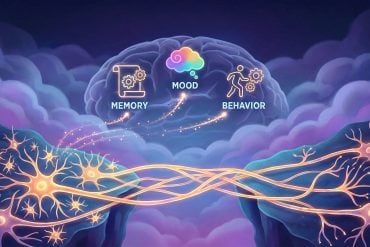Summary: New research heightened light sensitivity in Alzheimer’s patients to “sundowning,” a worsening of symptoms late in the day, and sleep disruptions that may advance the disease.
This fresh understanding of biological clock disruptions in Alzheimer’s could aid the creation of treatments and symptom management. Light therapy could potentially regulate erratic sleep patterns caused by altered circadian rhythms.
Further exploration of the disease’s effects on the biological clock might also offer preventative strategies.
Key Facts:
- Increased light sensitivity in Alzheimer’s patients may contribute to “sundowning” and sleep disruptions, potentially accelerating the disease’s progression.
- Light therapy could be a valuable tool to manage erratic sleep patterns in Alzheimer’s patients caused by altered circadian rhythms.
- A better understanding of Alzheimer’s effects on the biological clock may offer strategies for disease prevention, given that poor sleep quality in adulthood is an Alzheimer’s risk factor.
Source: University of Virginia
New Alzheimer’s research from UVA Health suggests that enhanced light sensitivity may contribute to “sundowning” – the worsening of symptoms late in the day – and spur sleep disruptions thought to contribute to the disease’s progression.
The new insights into the disruptions of the biological clock seen in Alzheimer’s could have important potential both for the development of treatments and for symptom management, the researchers say.

For example, caregivers often struggle with the erratic sleep patterns caused by Alzheimer’s patients’ altered “circadian rhythms,” as the body’s natural daily cycle is known. Light therapy, the new research suggests, might be an effective tool to help manage that.
Further, better understanding Alzheimer’s effects on the biological clock could have implications for preventing the disease. Poor sleep quality in adulthood is a risk factor for Alzheimer’s, as our brains, at rest, naturally cleanse themselves of amyloid beta proteins that are thought to form harmful tangles in Alzheimer’s.
“Circadian disruptions have been recognized in Alzheimer’s disease for a long time, but we’ve never had a very good understanding of what causes them,” said researcher Thaddeus Weigel, a graduate student working with Heather Ferris, MD, PhD, of the University of Virginia School of Medicine’s Division of Endocrinology and Metabolism. “This research points to changes in light sensitivity as a new, interesting possible explanation for some of those circadian symptoms.”
Alzheimer’s is the most common form of dementia, affecting 50 million people around the world. Its hallmark is progressive memory loss, to the point that patients can forget their own loved ones, but there can be many other symptoms, such as restlessness, aggression, poor judgment and endless searching. These symptoms often worsen in the evening and at night.
Ferris and her collaborators used a mouse model of Alzheimer’s to better understand what happens to the biological clock in Alzheimer’s disease. They essentially gave the mice “jet lag” by altering their exposure to light, then examined how it affected their behavior. The Alzheimer’s mice reacted very differently than did regular mice.
The Alzheimer’s mice, the scientists found, adapted to a six-hour time change significantly more quickly than the control mice. This, the scientists suspect, is the result of a heightened sensitivity to changes in light.
While our biological clocks normally take cues from light, this adjustment happens gradually – thus, jet lag when we travel great distances. Our bodies need time to adapt. But for the Alzheimer’s mice, this change happened abnormally fast.
The researchers initially thought this might be because of inflammation in the brain – “neuroinflammation.” So they looked at immune cells called microglia that have become promising targets in our efforts to develop better
Alzheimer’s treatments. But the scientists ultimately ruled out this hypothesis, determining that microglia did not make a difference in how quickly mice adapted. (That’s not to say that targeting microglia won’t be beneficial for other reasons.)
Notably, the UVA scientists also ruled out another potential culprit: “mutant tau,” an abnormal protein that forms tangles in the Alzheimer’s brain. The presence of these tangles also did not make a difference in how the mice adapted.
The researchers’ results ultimately suggest there is an important role for the retina in the enhanced light sensitivity in Alzheimer’s, and that gives researchers a promising avenue to pursue as they work to develop new ways to treat, manage and prevent the disease.
“These data suggest that controlling the kind of light and the timing of the light could be key to reducing circadian disruptions in Alzheimer’s disease,” Ferris said. “We hope that this research will help us to develop light therapies that people can use to reduce the progression of Alzheimer’s disease.”
The researchers have published their findings in the scientific journal Frontiers in Aging Neuroscience. The research team consisted of Weigel, Cherry L. Guo, Ali D. Güler and Ferris. The team members have no financial interest in the work.
Funding: The research was supported by the National Institutes of Health, grants K08DK097293, T32GM139787 and R35 GM140854; the Owens Family Foundation; and the Commonwealth of Virginia’s Alzheimer’s and Related Diseases Research Fund.
About this Alzheimer’s disease research news
Author: Josh Barney
Source: University of Virginia
Contact: Josh Barney – University of Virginia
Image: The image is credited to Neuroscience News
Original Research: Open access.
“Altered circadian behavior and light sensing in mouse models of Alzheimer’s disease” by Heather Ferris et al. Frontiers in Aging
Abstract
Altered circadian behavior and light sensing in mouse models of Alzheimer’s disease
Circadian symptoms have long been observed in Alzheimer’s disease (AD) and often appear before cognitive symptoms, but the mechanisms underlying circadian alterations in AD are poorly understood.
We studied circadian re-entrainment in AD model mice using a “jet lag” paradigm, observing their behavior on a running wheel after a 6 h advance in the light:dark cycle.
Female 3xTg mice, which carry mutations producing progressive amyloid beta and tau pathology, re-entrained following jet lag more rapidly than age-matched wild type controls at both 8 and 13 months of age.
This re-entrainment phenotype has not been previously reported in a murine AD model. Because microglia are activated in AD and in AD models, and inflammation can affect circadian rhythms, we hypothesized that microglia contribute to this re-entrainment phenotype.
To test this, we used the colony stimulating factor 1 receptor (CSF1R) inhibitor PLX3397, which rapidly depletes microglia from the brain.
Microglia depletion did not alter re-entrainment in either wild type or 3xTg mice, demonstrating that microglia activation is not acutely responsible for the re-entrainment phenotype.
To test whether mutant tau pathology is necessary for this behavioral phenotype, we repeated the jet lag behavioral test with the 5xFAD mouse model, which develops amyloid plaques, but not neurofibrillary tangles. As with 3xTg mice, 7-month-old female 5xFAD mice re-entrained more rapidly than controls, demonstrating that mutant tau is not necessary for the re-entrainment phenotype.
Because AD pathology affects the retina, we tested whether differences in light sensing may contribute to altered entrainment behavior. 3xTg mice demonstrated heightened negative masking, a circadian behavior measuring responses to different levels of light, and re-entrained dramatically faster than WT mice in a jet lag experiment performed in dim light. 3xTg mice show a heightened sensitivity to light as a circadian cue that may contribute to accelerated photic re-entrainment.
Together, these experiments demonstrate novel circadian behavioral phenotypes with heightened responses to photic cues in AD model mice which are not dependent on tauopathy or microglia.






